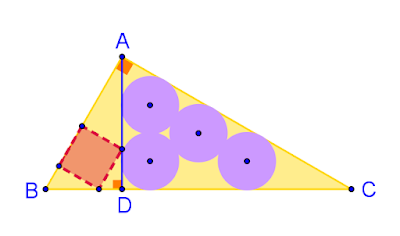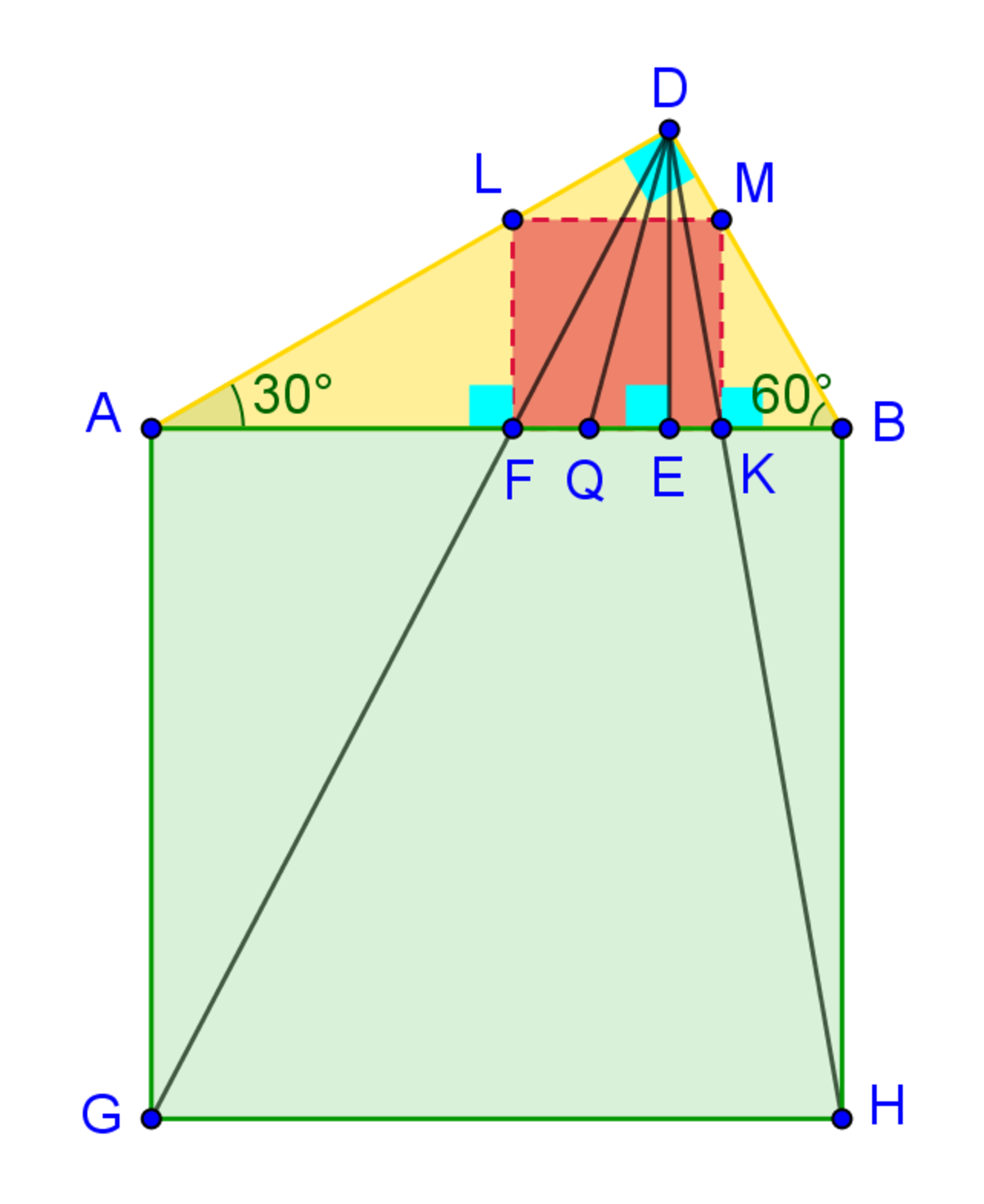1 Square and 4 Circles in a Triangle
In a right triangle A B C , the height A D to the hypotenuse is drawn. Four congruent circles of radius r are inside the triangle. Two of them are tangent to A D , to one side of the triangle and to each other. Another circle is tangent to two sides of the triangle. The fourth circle is tangent to one side of the triangle and to all three other circles. The smallest square that can be inscribed in triangle A B D has side of length s .
 Compare the side of the square to the radius of the circles. If their ratio is
r
s
=
β
α
(
γ
+
δ
)
, where
α
,
β
and
δ
are prime numbers, submit
α
+
β
+
γ
+
δ
.
Compare the side of the square to the radius of the circles. If their ratio is
r
s
=
β
α
(
γ
+
δ
)
, where
α
,
β
and
δ
are prime numbers, submit
α
+
β
+
γ
+
δ
.
Note: A square is inscribed in a triangle when its vertices lay on the sides of the triangle.
The answer is 27.
This section requires Javascript.
You are seeing this because something didn't load right. We suggest you, (a) try
refreshing the page, (b) enabling javascript if it is disabled on your browser and,
finally, (c)
loading the
non-javascript version of this page
. We're sorry about the hassle.
2 solutions
Denote the centers of the circles by
I
1
,
I
2
,
I
3
,
I
4
as shown on figure 1. Let
A
B
=
c
.
 figure 1
figure 1
The sides of △ I 1 I 2 I 3 are parallel to the sides of A D C , hence △ I 1 I 2 I 3 is right- angled. Since I 1 I 3 = 4 r = 2 I 1 I 2 , this triangle is a 3 0 ∘ - 6 0 ∘ - 9 0 ∘ triangle. Consequently, the same holds for △ A D C , △ A B C and △ A B D .
A D = A J + J D = r cot 3 0 ∘ + 3 r = r ( 3 + 3 )
c A D = sin 6 0 ∘ ⇒ c = 2 r ( 3 + 1 ) ( 1 )
In figure 2, we have isolated △ A B D , to illustrate a construction of the inscribed square and calculate its side s .
First we construct square
A
B
H
G
outside
△
A
B
D
.
D
G
and
D
H
intersect
A
B
at
F
and
K
respectively. Lines
L
F
,
M
K
and
D
E
are perpendicular to
A
B
.
 figure 2
figure 2
Due to triangle similarity,
A G L F = D G D F = G H F K ⇒ A G = G H = c L F = F K Likewise, M K = F K , thus, L F K M is a square inscribed in △ A B D .
Again, taking advantage of triangle similarity,
K E B K = D E B H ⇒ B K + K E B K = c + D E c ⇒ B D ⋅ cos 6 0 ∘ B K = c + B D ⋅ sin 6 0 ∘ c ⇒ B D = 2 c B K = 4 + 3 c
Now, for the side of the inscribed square we have
s = M K = B K ⋅ tan 6 0 ∘ = 4 + 3 c ⋅ 3 ⇒ s = c ⋅ 1 3 4 3 − 3 ( 2 )
( 1 ) , ( 2 ) ⇒ s = 2 r ( 3 + 1 ) ⋅ 1 3 4 3 − 3 ⇒ r s = 1 3 2 ( 9 + 3 ) For the answer, α = 2 , β = 1 3 , γ = 9 , δ = 3 , hence α + β + γ + δ = 2 7 .
To prove MNOP a square inscribed in triangle ABD , have followed the same process as @Thanos Petropoulos .